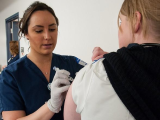Jun 14, 2007 (CIDRAP News) – Vical Inc. has been awarded a $6 million federal grant to develop a DNA vaccine manufacturing process that the company says may dramatically speed up production of vaccines for influenza and other diseases.
In announcing the grant in a Jun 12 news release, the San Diego company said its process has "the potential to produce several million doses of vaccines in a matter of days." But officials predicted it will take several years to develop and scale up the process to produce even enough vaccine for clinical trials.
The 3-year grant was awarded by the National Institute of Allergy and Infectious Diseases (NIAID), part of the National Institutes of Health.
Vical President Vijay Samant said the company's RapidResponse system is designed to allow fast, large-scale production of DNA vaccines at low cost and is ideal for responding to emerging diseases such as pandemic flu and SARS (severe acute respiratory syndrome).
The company said the system uses polymerase chain reaction (PCR) to make small segments of DNA, called linear expression cassettes, that include only the DNA sequences essential for the vaccine.
Conventional flu vaccine production involves growing the target virus in eggs, which takes several months, and then killing the virus before incorporating it into a vaccine (though one vaccine involves a live, weakened virus, also grown in eggs). Several companies are working on producing flu viruses or pieces of them in cell cultures, a process said to be more flexible and somewhat faster than egg-based production. The European Union approved a cell-based flu vaccine this week.
DNA vaccines contain small pieces of the target pathogen's genetic material instead of a killed or weakened form of the virus. In a separate project, Vical is developing an H5N1 avian flu vaccine that is produced in cell culture, but the RapidResponse process represents a step beyond that, the company said.
"The new RapidResponse platform does not use any type of cell-based process. It's a chemical synthesis enzyme reaction," Alan Engbring, Vical's executive director of investor relations, told CIDRAP News.
Engbring said the RapidResponse system "has potential use for a wide variety of pathogens, but our development work is likely to be with influenza. It's a readily accessible virus, it's well characterized, the biology of protection is well understood, there are ready assays available to determine immunogenicity, and there are animal models available."
Initial research on the process was funded by the US Defense Advance Research Projects Agency (DARPA), the company said. In that work, a single 2-microgram dose of the PCR-produced vaccine protected mice from a lethal dose of H3N2 flu virus, a common human subtype.
Engbring said he expects that the 3-year NIAID grant will enable Vical to speed its process to make enough doses of vaccine for clinical trials and to do some preclinical tests. He said it is too early to predict how long it might take to develop the process to the point of commercial-scale production.
The company statement said the RapidResponse process could potentially be scaled up by using larger equipment without adding to production time, "conceivably allowing production of hundreds of millions of doses of DNA vaccine during the earliest stages of an outbreak."
Vical's ongoing H5N1 vaccine project is well ahead of the RapidResponse program, Engbring said. For the H5N1 vaccine, Escherichia coli is used to produce a plasmid, or loop of DNA, containing genetic material from the target virus. Production time is "measured in weeks"—faster than with egg-based production, but slower than what the RapidResponse system promises to make possible, the company said.
The company's goal is to start a phase 1 clinical trial of the H5N1 vaccine in the second half of this year, Engbring said. "It wouldn't make sense to stop that program to wait for this one to catch up. We do intend to keep moving forward with the plasmid-based H5N1 program. Eventually these could merge somewhere down the road, but right now we're keeping them separate."
See also:
Jun 7, 2006, CIDRAP News story "Firm gets funds for work on avian flu DNA vaccine"


















